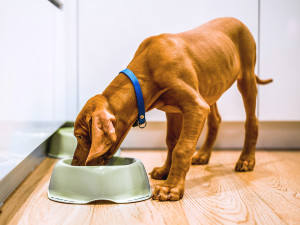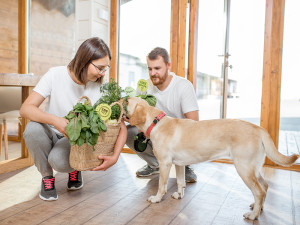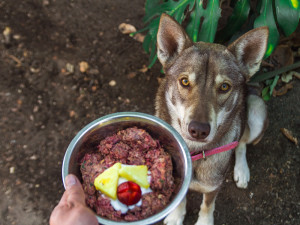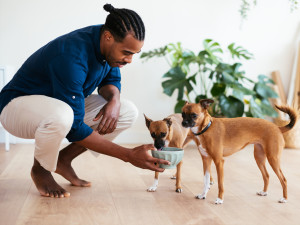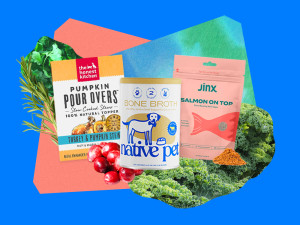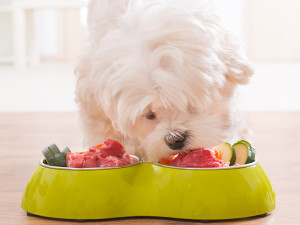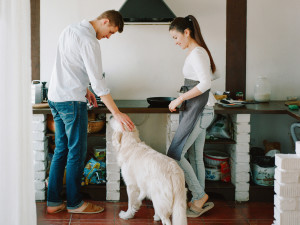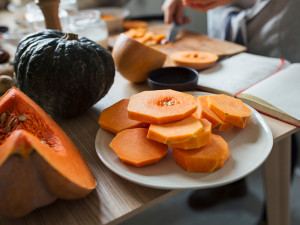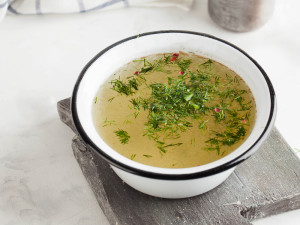Wholesome Homemade Dog Food Recipes: Vet-Approved Starter Recipe
All it takes is healthy ingredients and a slow cooker.
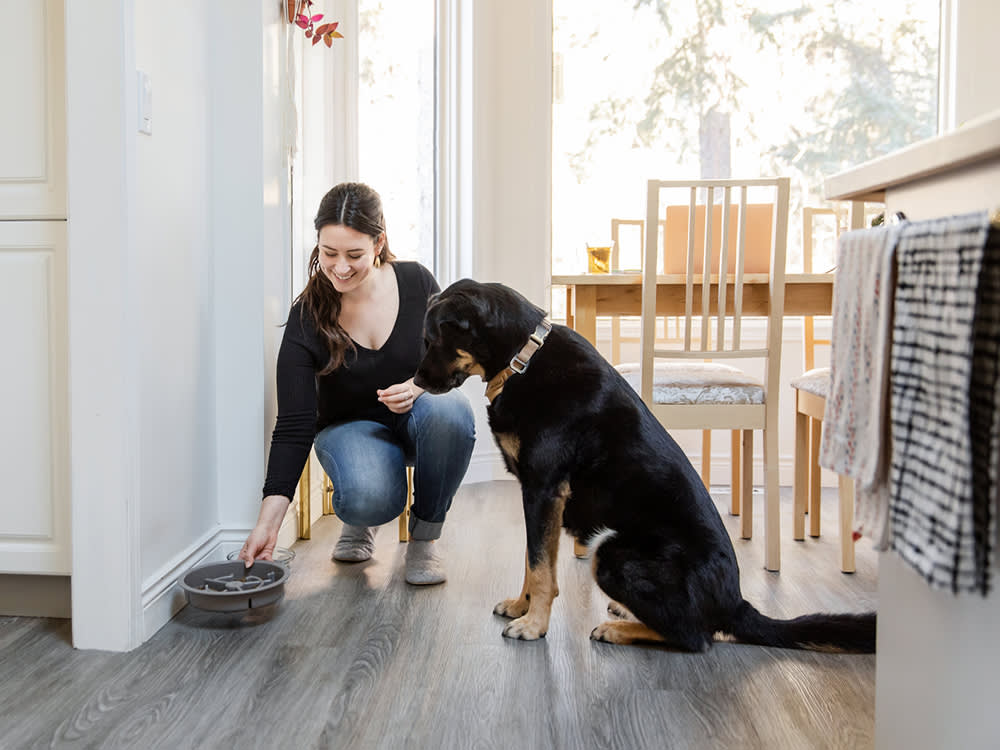
Share Article
If you’ve put in the time and effort to create a healthier diet for yourself at home, why not put those well-honed skills to use for your pet? Homemade dog food recipes can help you control the ingredients in your pet’s food and eliminate annoying allergic reactions, but preparing this type of food definitely takes time, effort, and a whole lot of fresh ingredients.
Learn exactly what goes into safe homemade dog food and how to plan out this type of diet for your dog, and get started with a vet-approved slow cooker recipe.
Why should I consider making homemade dog food?
One of the main benefits of making homemade food is that they help pet parents control the ingredients in their dog’s food. Focusing on dog nutrition, homemade food gives you the opportunity to choose the freshest and highest-quality ingredients, and the level of control makes these recipes excellent for dogs with food allergies or other dietary sensitivities. You can also add some homemade food to the store-bought brand your dog already likes, if you want to add some variety to their diet, but talk to their vet first.
How do I ensure my homemade dog food is nutritionally balanced?
Just like humans, dogs have specific nutritional needs, and feeding your pup an incomplete or imbalanced diet can result in vitamin and nutrient deficiencies. Your homemade dog food recipe should include the right amounts of protein, carbohydrates, fiber, and fats to keep your pet healthy and allow them to enjoy all the benefits of homemade dog food.

What are the essential ingredients for homemade dog food? In general, a nutritionally complete homemade dog food recipe should include:
At least 10 percent protein, such as chicken, fish, turkey, or lean beef
Up to 50 percent carbs, like rice, pasta, and potatoes (also a great source of fiber!)
2.5 to 4.5 percent fiber, which can be found in vegetables such as peas, green beans, and carrots
Around 5.5 percent fat
Vitamins and mineral supplements
Before you start googling how to make food for dogs, talk to your vetopens in new tab. Not only do they likely have recipes to recommend, but your vet can help determine the best weight for your dog and ingredients to focus on, like the best carbs for homemade dog food. Your veterinarian may even refer you to a veterinary nutritionist or a specialist in canine nutrition, who can help you find the right meals or tell you how to freeze dry dog food recipes or prepare ingredients in a slow cooker.
Slow-cooking veggies — from kale to parsnips to sweet peas — increases palatability. You can produce around nine pounds of food with two, seven-cup cookers. Be sure to alternate the protein sources from turkey and chicken to beef and pork, plus vary the vegetables, fruits, and carbohydrates.
For optimum performance, fill the cooker to about two-thirds capacity, and not less than halfway; don’t over-or-under fill.
Six-to seven-quart cookers work best.
Keep the lid on. Slow cookers can lose 20 to 30 minutes of cooking time if the lid is removed.
One hour on the high setting equals two to two and a half hours on low.
Remove excess fat from meats and the skin from poultry. Brown ground meats and drain off the residual fat before putting them in the cooker.
Never put frozen foods into a slow cooker. Defrost ingredients before adding.
Cut all ingredients into uniform pieces so they cook evenly.
Put the densest ingredients — sweet potatoes, potatoes, carrots, and heavier root veggies such as parsnips, turnips, and rutabagas — on the bottom. Then add the meat and top off with other veggies and fruit.
Grains absorb a lot of liquid. If you cook them with the other ingredients, you may have to add more water during the cooking process. This is especially true if you’re using brown rice. It’s best to add the grains and legumes that require only light cooking (oats, millet, whole wheat couscous, barley, bulgur, quinoa, lentils, and split peas) three-quarters of the way through cooking. Or, cook them separately and mix them in afterward. (If you do prepare them separately, cook them in the excess broth from the stew, which is tasty and rich in nutrients.)
Meat and veggies may need to be broken into smaller pieces before feeding to your dog. Transfer the cooled meal to a large bowl, then use a potato masher, spatula, or the back of a wooden spoon to mush it all together and tear apart the chunks of meat. You can also use a food grinder or processor.
Meat contains a lot of water and shrinks during cooking. Find out just how much by consulting the USDA websiteopens in new tab. This is important to understand because cooking a pound of chicken, for example, results in much less meat in the finished product, meaning fewer calories and assorted nutrients. So, in calculating calories and nutrients, consider the “after cooking” weight.
Adjust the protein-to-carb ratio by simply adding more meat to your recipe. You can even cook some additional meat separately and add it to the finished product at mealtime.
Let the food cool down before packaging it in freezer-safe containers. Meals stay fresh for three to four days in the refrigerator. Defrost frozen meals in the refrigerator, not at room temperature.
Vet-approved homemade dog food starter recipe
If you’re looking for homemade food and homemade dog treat recipes easy enough for beginners, try starting out with this vet-approved recipe. Adapted from veterinarian Greg Martinez’s starter recipe, this slow-cooker homemade dog food recipe is higher in protein (about 50 percent dry matter) and lower in fat (about 10 percent dry matter) than in most recipes.
But, because every pet is a unique weirdo with specific needs, use this recipe only as a starting point — talk things over with your veterinarian about your dog’s particular medical and dietary needs.
How much homemade dog food should I feed my dog?
Figuring out how much to feed your dog can be confusing. But when it comes down to it, the number of calories a dog needs on a daily basis can be determined by a variety of formulas. So, when you’re trying to determine how much homemade food to feed your dog (especially if it’s in addition to their kibble), take time to calculate your pet’s energy requirements based on their age, breed, and activity level.
The first thing to do is to calculate how many kilocalories your dog requires on a daily basis (daily energy requirement or DER). The total calorie requirement should then be divided by the number of meals fed to your dog daily (usually two). All treats and snacks also need to be accounted for (you might have to check with treat makers for nutritional facts), and their calories should be subtracted from the total to be provided in their meals.
Of course, it’s always recommended that, before making changes to a dog’s diet, you discuss the plan with your veterinarian. Also, keep in mind that there are a number of different approaches that are used to calculate a dog’s caloric needs, so other formulas may yield slightly different results.
How much you feed will also depend on how much your dog weighs (as well as their body condition score) and how active they are. Dr. Christine Zink, a veterinarian and leading expert on canine sports medicine, provides good thumbnail guidelines for activity: “An inactive dog is one who rarely gets more than a jaunt around the yard, a moderately active dog is one who gets 15 to 30 minutes of continuous exercise every day, an active dog is one who walks twice daily for about 45 minutes each time, and a highly active dog is one who gets at least several hours of exercise every day.”
It’s important to remember that dogs are individuals. No matter what type of calculation you use, the best way to judge a feeding plan’s efficacy is by simply keeping track of any weight loss or gain, and then adjusting accordingly.
Are there any risks or considerations I should be aware of?
If you’re planning to dive into the world of homemade dog food, be aware of the risks of a raw diet for dogs, as well as the challenges of making your own dog food. Raw diets bring with them added risk of diseases, such as salmonella, and homemade dog food diets must be complete and balanced to ensure your dog gets all the nutrients they need.
Changing your dog’s diet should be done gradually, by mixing the new food with their old food and slowly increasing the percentage of new food. You should also keep an eye out for any adverse reactions your dog has, which may be the result of food allergies. Common food allergies in dogs include wheat, eggs, chicken, and beef.
Is it safe to make homemade dog food?
It can be completely safe to make your own dog food as long as you invest the time into developing a dietary plan with your vet. Monitor your dog as you add in the homemade food and keep a record of any changes in their weight or body. Stay in touch with your vet to let them know how the diet change is progressing and contact your veterinarian immediately if you notice vomiting or diarrhea.
FAQS (People Also Ask):
Can I freeze homemade dog food?
Many pet parents prepare homemade dog food in bulk and refrigerate or freeze some food in pre-portioned containers. If you choose to freeze homemade dog food, make sure to use it within two months and avoid feeding your dog any food that has been in the freezer for more than six months.
Is it expensive to make your own dog food?
Homemade dog food is generally less expensiveopens in new tab than fresh or raw dog food, but it’s definitely more costly (and more time-consuming to prepare) than kibble, so be fully aware of the cost of making your own dog food before you dive in.
Disclaimer alert: This article is here to share information. But, much like pineapple on pizza, the topic may be controversial. Meaning, not all vets or pet professionals agree. Because every pet is a unique weirdo with specific needs. So, don’t take this as fact or medical advice. Talk things over with your vet when making decisions, and use your best judgment (about both your pet’s health and pizza toppings).

Savannah Admire
Savannah Admire is a writer and pet mom to two dogs and a cat. Under the name Savannah Cooper, she has published poetry in 40 different publications, as well as a poetry book, Mother Viper (2025). When she’s not writing, you can find her reading, taking photos, or volunteering as a content creator for her local community theatre. As a pets writer, she focuses on cat and dog behavior and pet parenthood. She currently lives in Western Maryland.
Related articles
![White terrier eating fresh dog food]()
The Scoop on Human-Grade Dog Food
For starters, yes, it’s good enough to eat.
![Young couple petting their dog in the kitchen while they make homemade kibble]()
How to Make Homemade Dog Kibble
Learn how to make dry dog food with this easy homemade dog kibble dish.
![A man holding out a dog biscuit to a Dalmatian on a kitchen floor.]()
Recipe for Seeded Dog Biscuits
Learn how to make your own basic dog biscuits packed with nutritious seeds and sweet apples.
![Close up of chopped pumpkin with person chopping pumpkin in the back]()
How to Turn Your Jack-o’-Lantern into Dog-Friendly Pumpkin Puree
This simple recipe can serve as the base for dog treats.
![Man shopping in a pet store reading product information]()
Your Comprehensive Guide to Eco-Labels on Pet Products
Here are the sustainability buzzwords you should look out for on the packages of your fave products.
![Bone broth soup]()
Let Your Dog Lap Up Your Bone Broth
It isn’t just a healthy cocktail for the likes of Gwyneth Paltrow and Kylie Jenner. And we’ve got a recipe.
